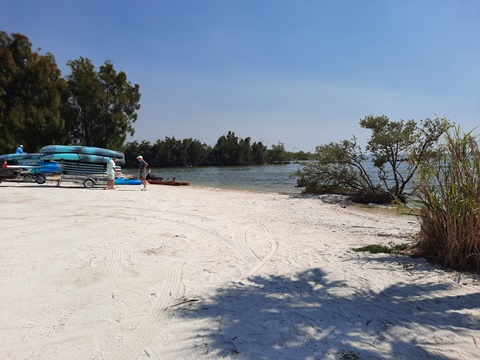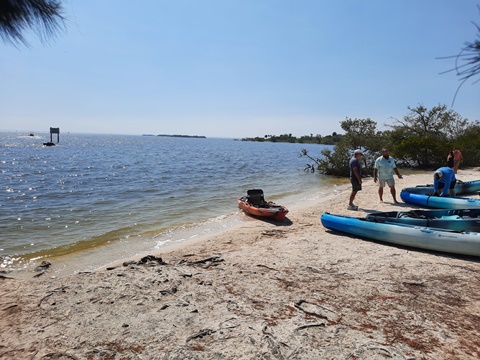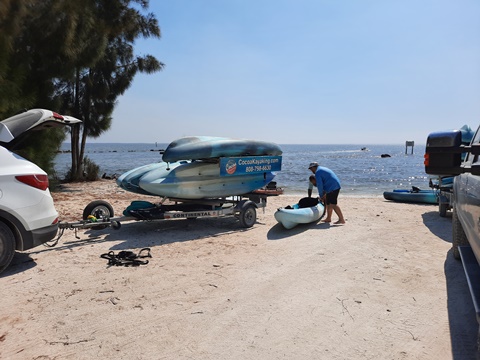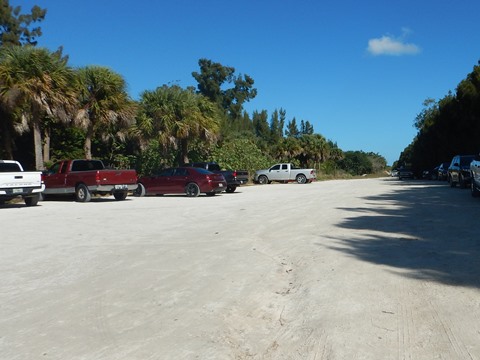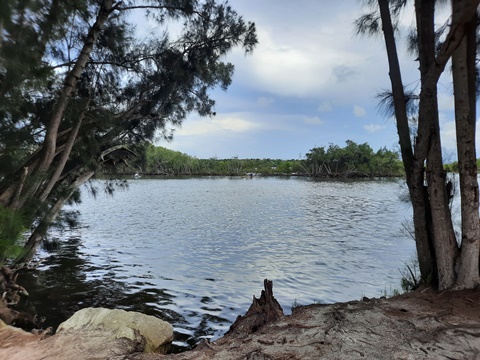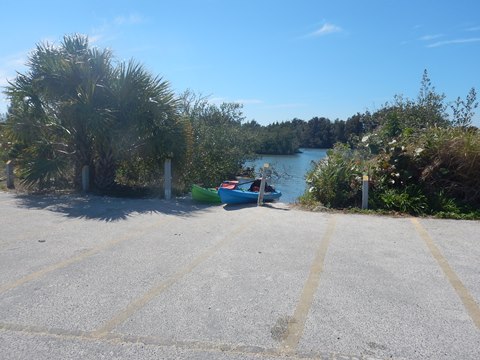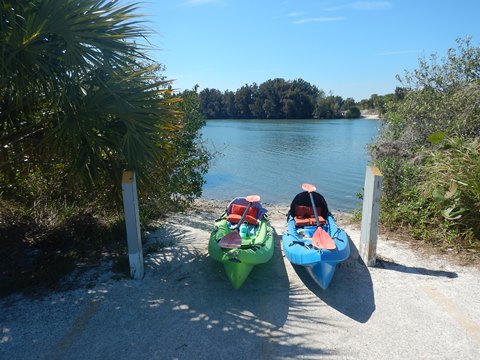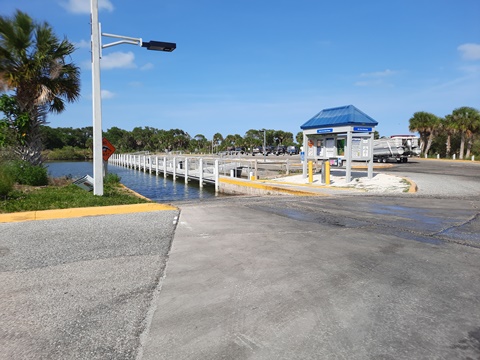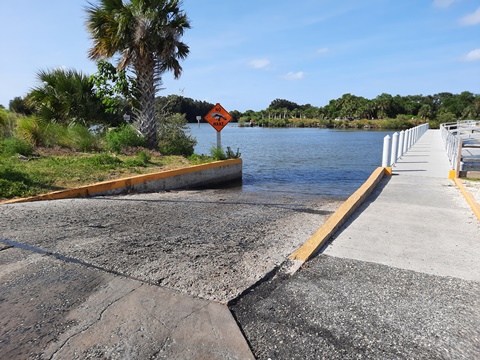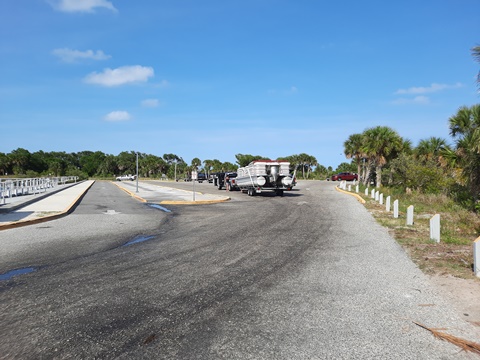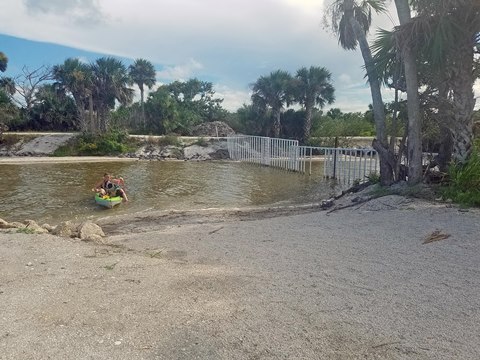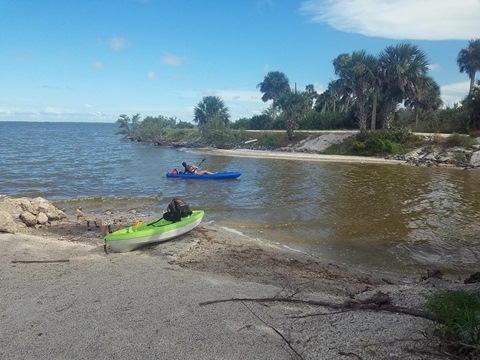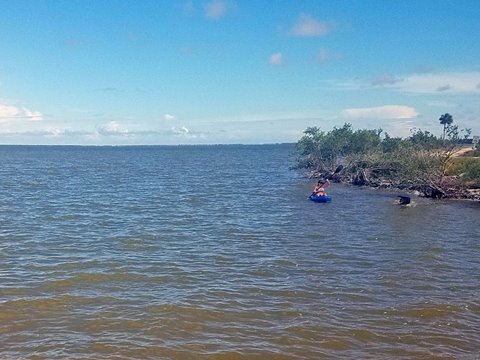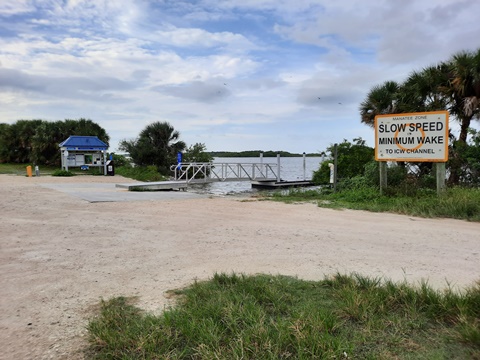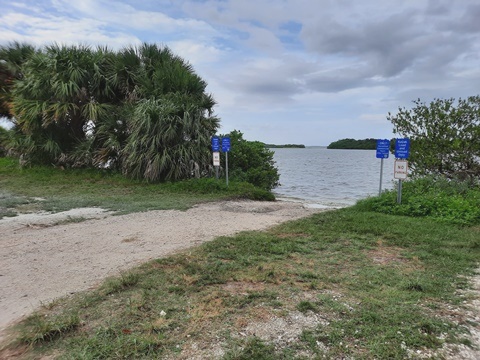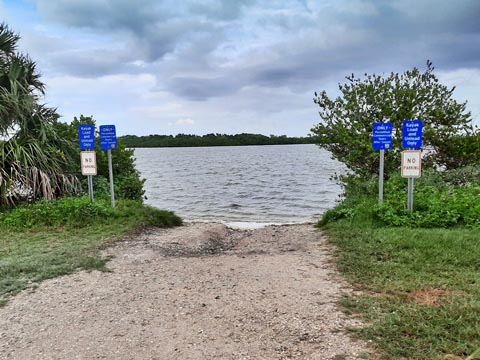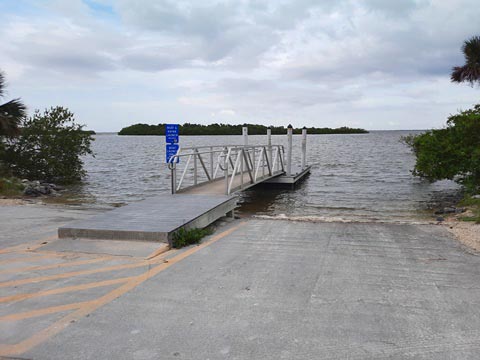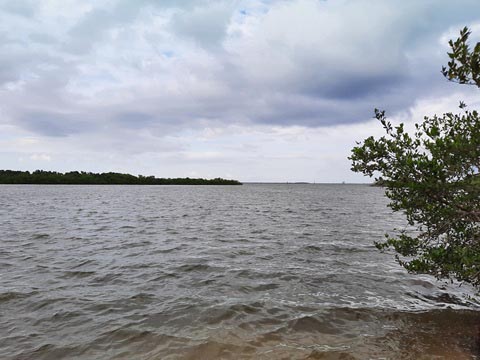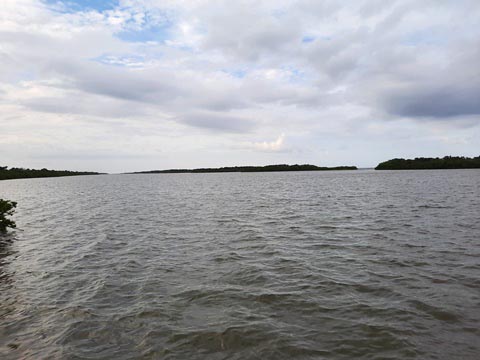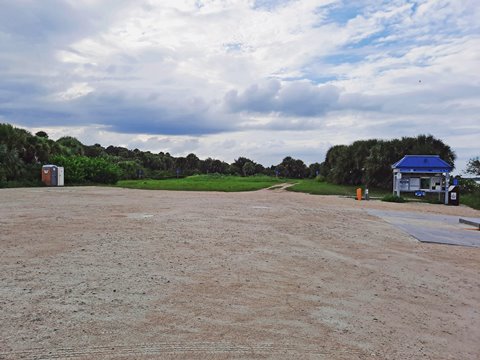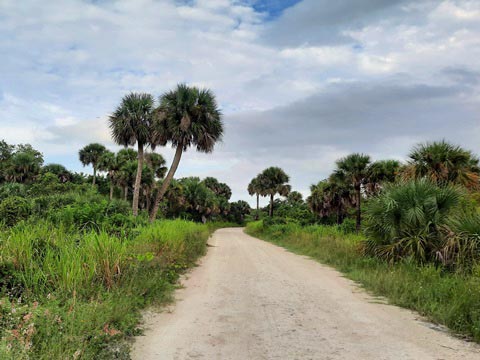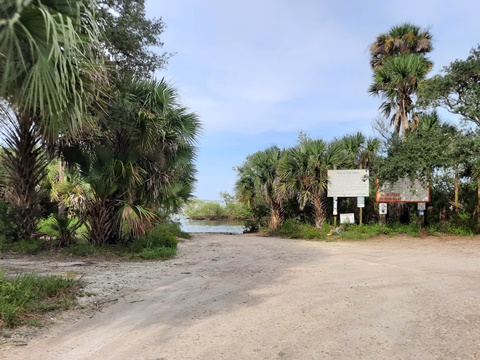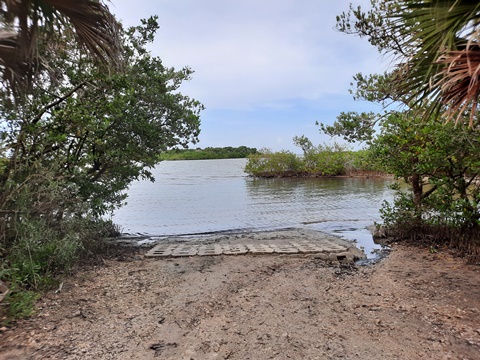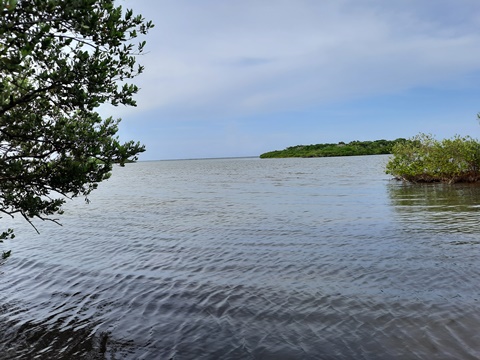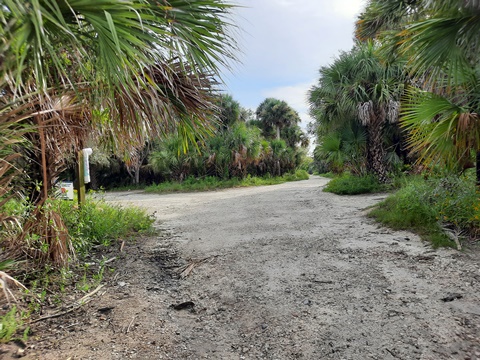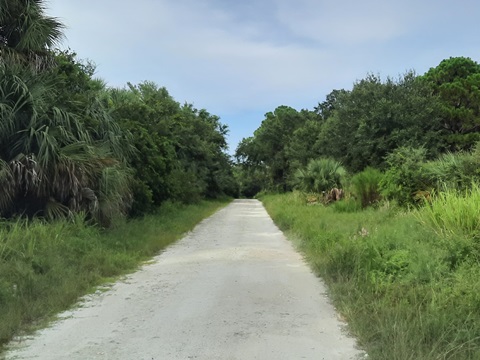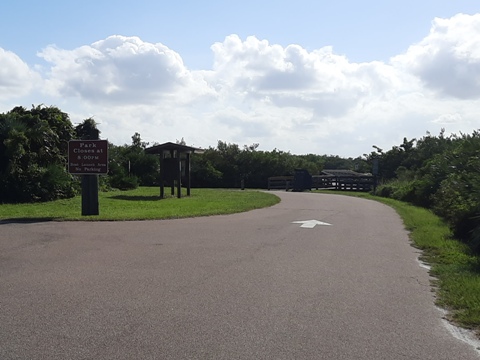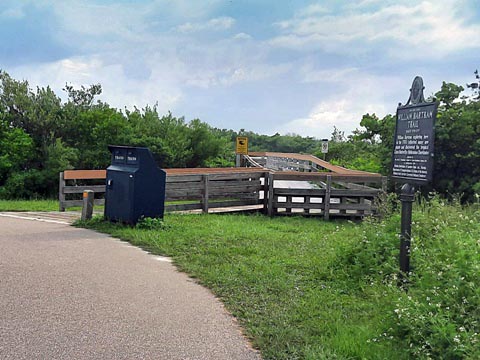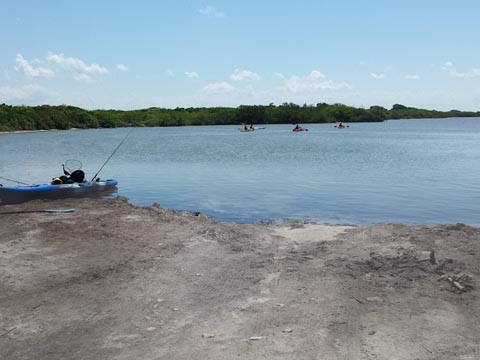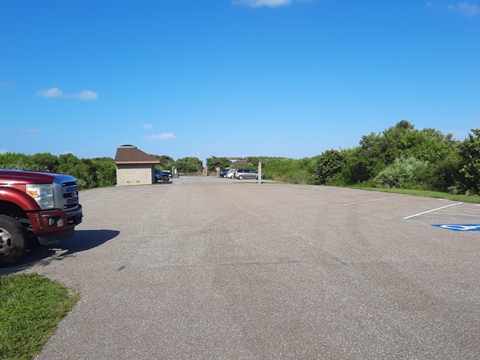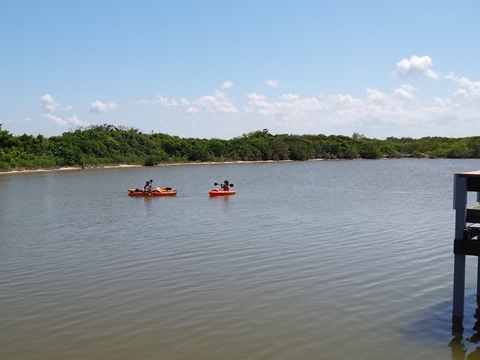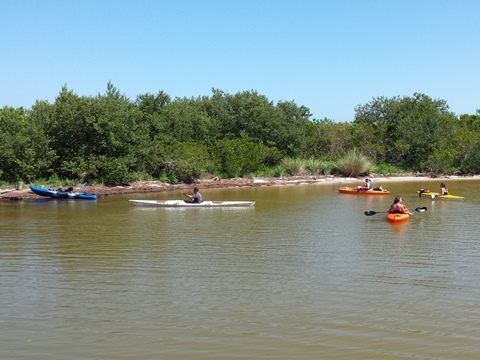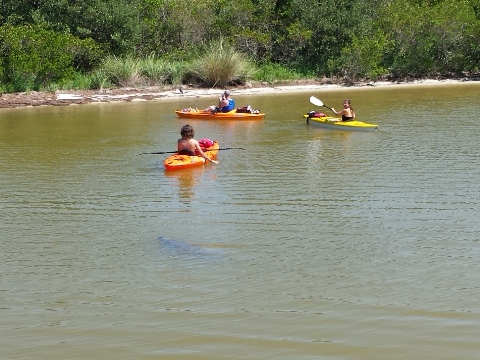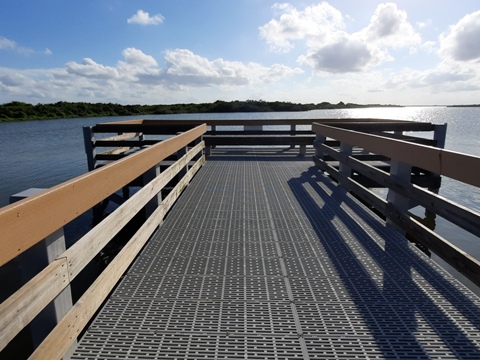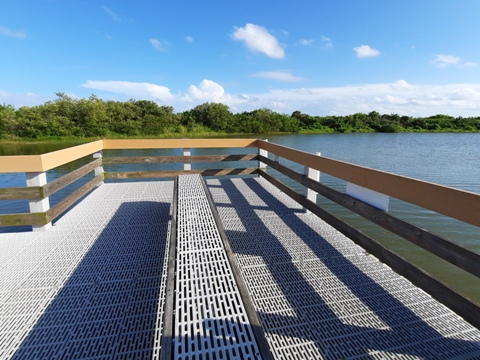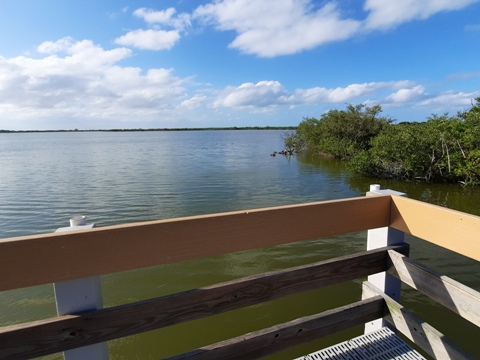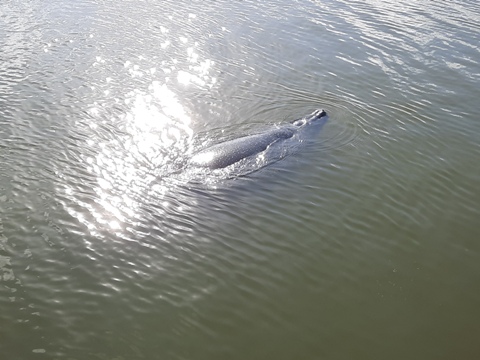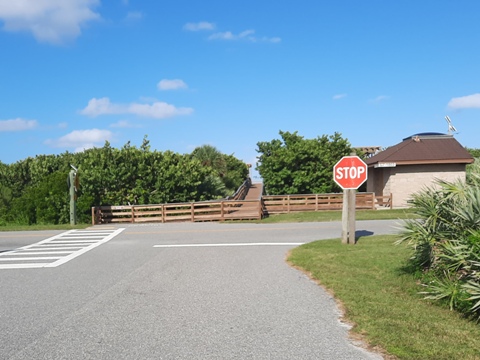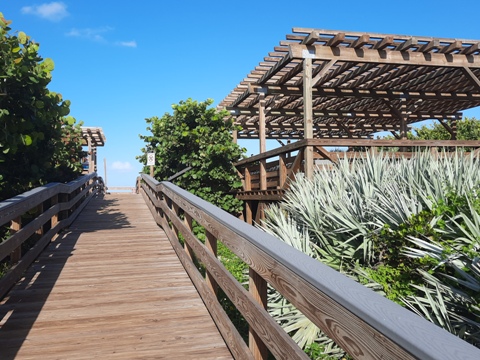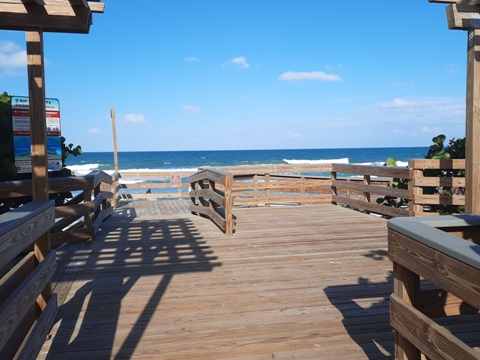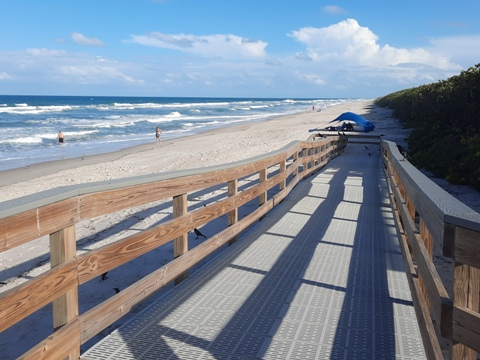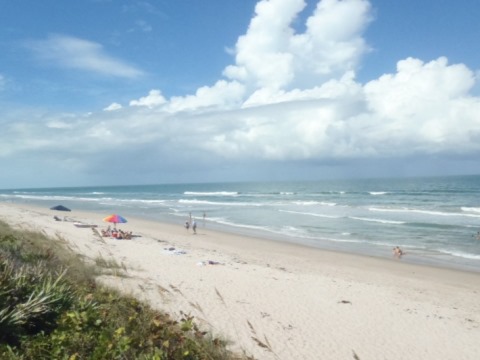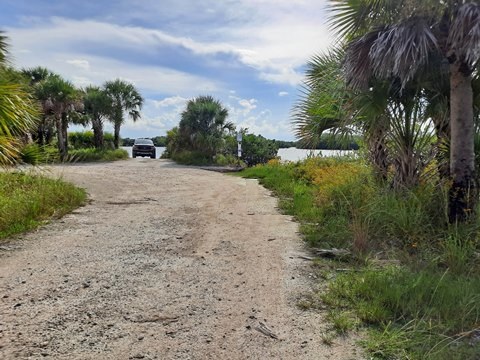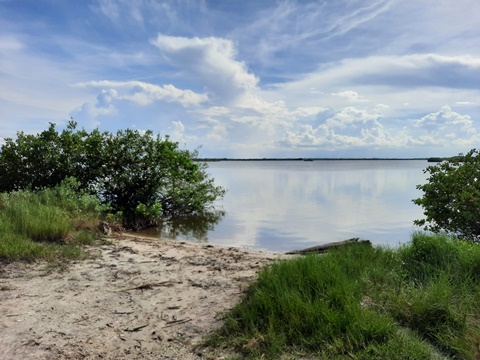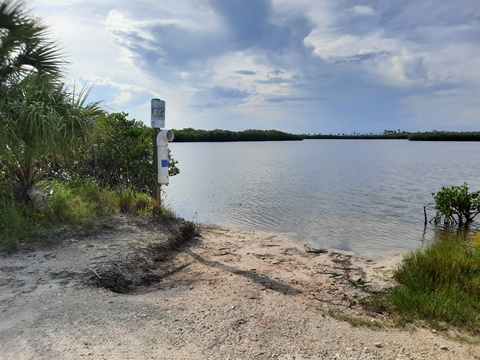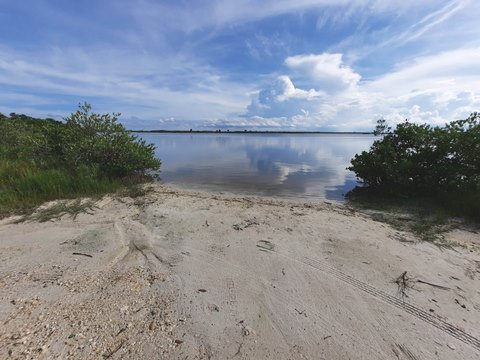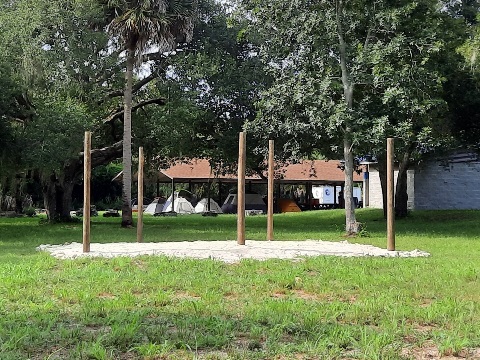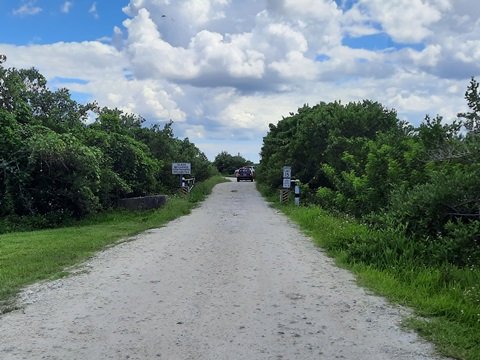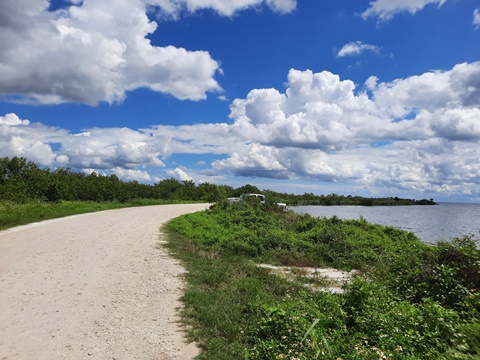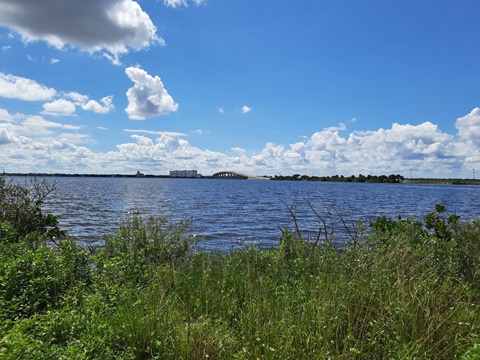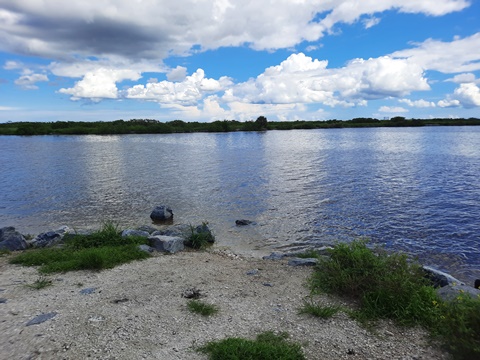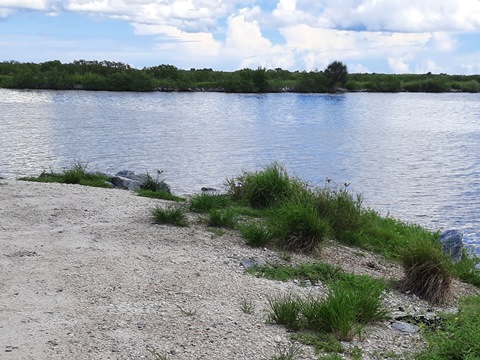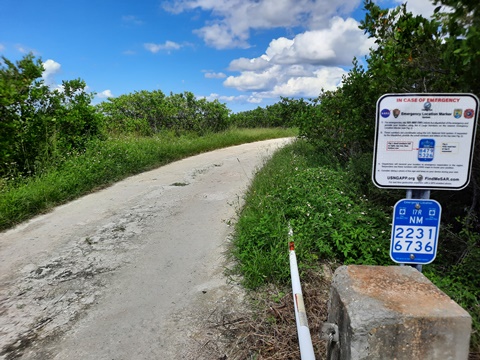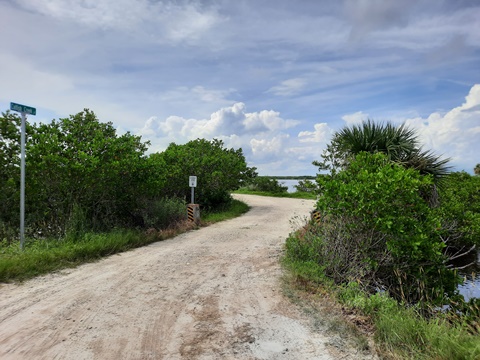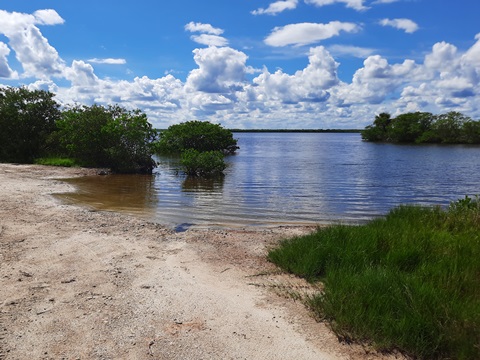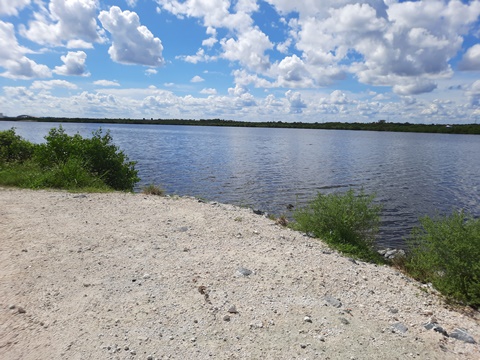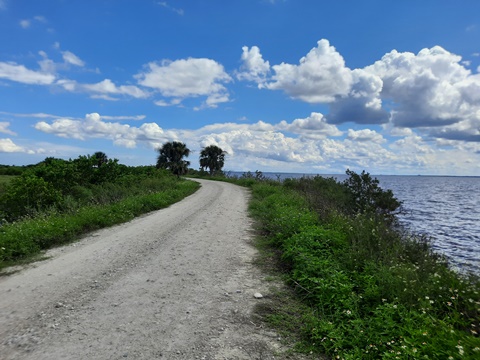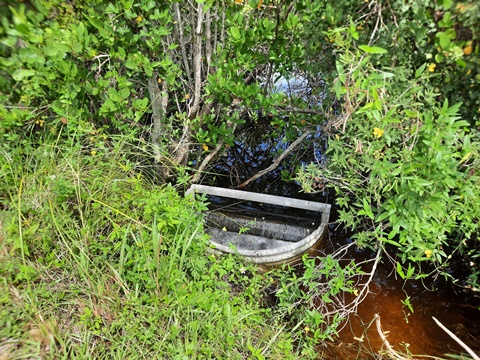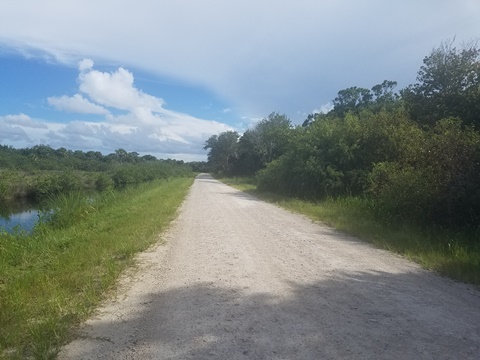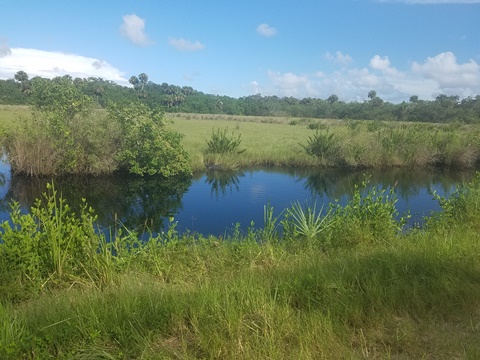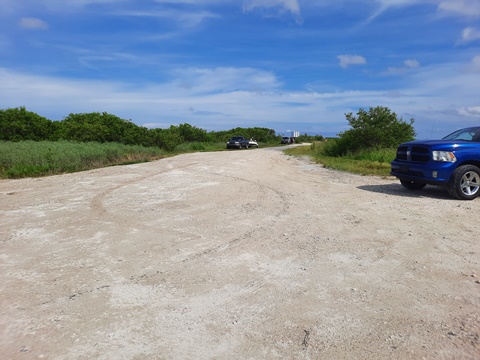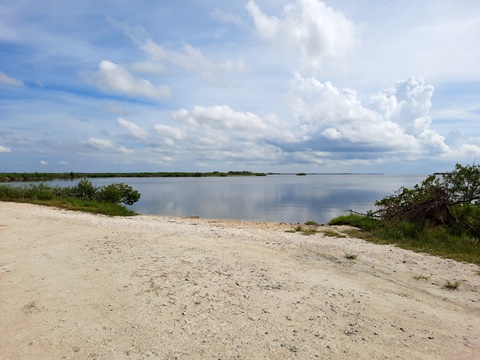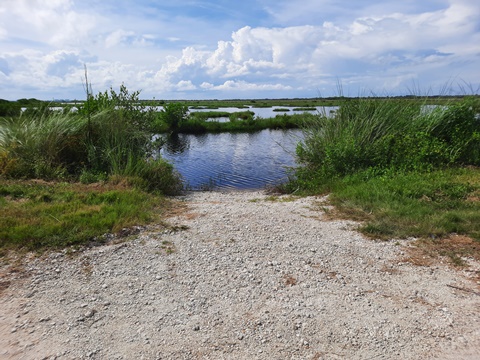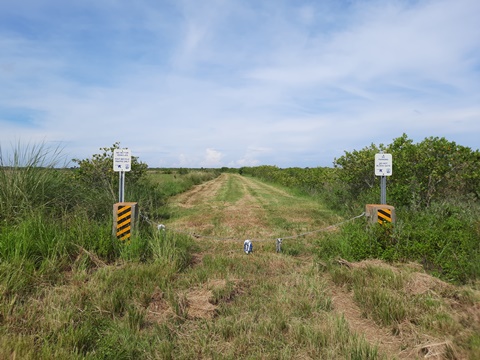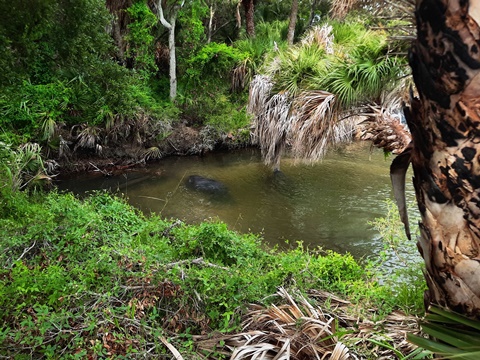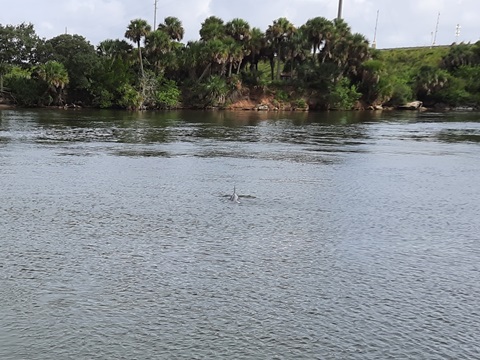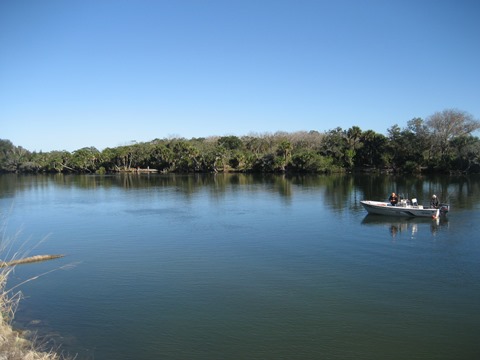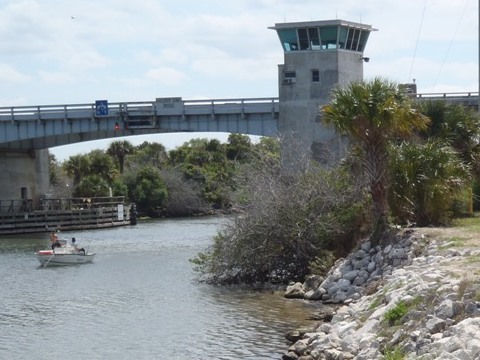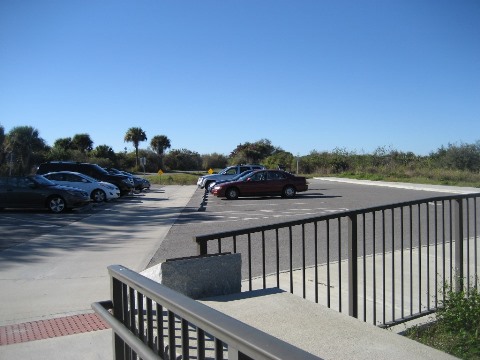Paddle Florida®
Over 100 Florida Paddling Destinations
E-Z Maps... Photos... Reports...
You are here > Home >
East-Central Florida >
Merritt Island
Latest update: October 2022
Merritt Island National Wildlife Refuge... Florida
Kayaking with Wildlife on Mosquito Lagoon and Upper Indian River Lagoon
The 149,000 acre Merritt Island National Wildlife Refuge (NWR) was established in 1963 as part of the Canaveral (John F. Kennedy) Space Center. It is an eco-tourism gem that provides important habitat for a wide variety of plants and animals, especially migrating birdlife. Recreational opportunities include Wildlife Drive, a manatee observation deck, bird watching, paddling, fishing, hiking, and (seasonal) hunting. There's choice of launches, starting with Haulover Canal, connecting Mosquito Lagoon (world famous for large redfish) and Upper Indian River Lagoon (popular for bioluminescence tours). Shallow lagoon waters confine most motorboats close to the channel, but ideal for kayaks. Free fishing permit (at Visitors Center) required for those wishing to try their luck. (Detailed map and photos below).
Information here is subject to change due to storm damage, maintenance, or Refuge policy. Check for current closures
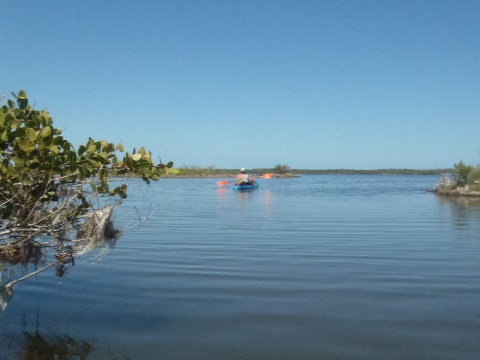
Distance: varies
Location: Brevard County (Titusville)
Difficulty: Easy to Moderate
Tidal: Yes
Launch points: Along Shiloh Marsh Road, NW Haulover Canal
Access, Bairs Cove, Beacon 42
Boat Ramp, WSEG Boat Ramp, Dummitts Cove, Bio Lab Road, Eddy Creek (See map)
Nearby points of interest: Manatee Observation Deck, Kennedy Space Center,
Canaveral National Seashore, Playalinda Beach
Support and Advocacy:
Merritt Island Wildlife Association
Rentals/Outfitters/Tours - includes Bioluminescence Tours
(*only permitted outfitters may operate from within the NWR):
A Day Away Kayak Tours
(rentals/tours)
BK Adventures
(rentals/tours)
Cocoa
Kayaking (kayak & paddleboard
tours)
Florida Adventurer (kayak
tours)
Get Up and Go Kayaking
(bioluminescence kayak tours)
Others nearby:
A1A Beach Rentals
(rentals/tours)
Kayaks by Bo
(sales)
Page Summary:
- Paddling at Merritt Island National Wildlife Refuge.
- Paddling at Haulover Canal
- Two Launches
- Mosquito Lagoon
- Indian River - Other Launches onto Mosquito Lagoon
- Biolab Boat Ramp and Launch
- Beacon 42 Boat Ramp
- WSEG Boat Ramp (Pole and Troll) - Paddling on the Upper Indian River Lagoon
- Launch at Shiloh Marsh Road and Canals
- On the Upper Indian River Lagoon
- Dummitt Cove - Launching from Dikes along the Indian River
- Gator Creek, Catfish Creek, Peacocks Pocket - Wildlife
- Manatee Observation Deck - About the Indian River Lagoon
- More Information and Resources
Paddling at Merritt Island National Wildlife Refuge... Comments and Photos
Hand-launch is allowed anywhere within the NWR except: (1) Kennedy Space Center restricted areas, (2) along Wildlife Drive, or (3) areas closed for maintenance. Here we document ten kayak launches on NWR waters. Two of the most popular are on Haulover Canal (1.5 miles, connects the two lagoons). We also visited dikes around Gator Creek, Catfish Creek, and Peacocks Pocket, plus one launch onto NWR waters at Canaveral National Seashore (south entrance) directly across from the beach. Watch the weather, as high winds can create difficult paddling conditions on shallow waters. In the summer months, bioluminescence is an interesting phenomenon and outfitters offer tours - marine life have developed the ability to use chemicals within their bodies to produce light, visible at night.
Paddling at Haulover Canal
Two Launches
The wide (200' to 300') Haulover Canal links Mosquito Lagoon (east side) to the Indian River Lagoon (west side). It's a popular area for fishing, manatee viewing, daytime kayaking tours, and nighttime bioluminescence kayaking tours. The launches are located on opposite sides of the Canal, west of drawbridge. Be prepared for some tidal influence and mild wake from slow-moving motorboats (manatee zone). In all, we find paddling the wide Canal to be pleasant; tree-lined, with shelter from wind, many birds, a few manatee, maybe dolphin, and possibly an alligator for the "Florida Trifecta."
History - This location is near the former site of the fishing community of Allenhurst, one of several that were vacated when the land was acquired by NASA for the space program. But the area has a longer history, dating to Native American and Spanish occupation. During the Seminole Wars, Fort Ann (1837) stood near here. The first canal was built in 1854, and in 1888 rebuilt and widened to accommodate steamship and cargo ships. It was incorporated into the Intracoastal Waterway in 1927. (More about Haulover Canal for history buffs )
Launch at NW Haulover Canal Access
The access road to "NW Haulover Canal Access" (official name) is off N. Courtenay Pkwy., just north of the drawbridge (west side). A bumpy dirt road, at the end a wide beach area provides an easy-on-off launch onto a small cove where the Haulover Canal meets the Indian River Lagoon. Parking, portalet. This launch is favored by local kayak tour operators (with NWR permits) and for pure recreational kayaking, it's one of our favorites as well. Launching is possible at spots along the access road, but more often than not, these spots are taken by fishermen.
Kayak Launch at Bairs Cove Day-use Area
Accessed from N. Courtenay Pkwy., on the south side of the canal, the Bairs Cove Day Use Area has paved parking, portalets, a small paved boat ramp, and a separate kayak launch. The boat ramp launches inside a boat basin along the canal, while the kayak launch is directly onto the canal, just west of the basin. This is a good area to spot manatee. A NWR day-use fee applies when launching a motorboat from here, or anywhere within the NWR. There is no fee to launch non-motorized watercraft.
Paddling the Haulover Canal from Launch onto Mosquito Lagoon
Canal to Mosquito Lagoon
From the launch, the Haulover Canal begins immediately to the left. Paddling eastward, the Canal passes Bairs Cove boat launch (south side), goes under the drawbridge, passes the Manatee Observation Deck (north side), and exits onto Mosquito Lagoon. On this day, we didn't see any manatee at the observation deck, but there were 2 or 3 lounging along the south shoreline between Bairs Cove and the drawbridge. We like paddling close to the shoreline due to the many slow-moving motorboats (part of the Intracoastal Waterway) and the Canal is wide enough to do so comfortably. West of the drawbridge, we recommend paddling on the south side of the Canal, as there are many fishermen with lines out along the north side. Once past the drawbridge, the opposite is true.
Dredge Islands along Mosquito Lagoon
Shortly before the east end of Haulover Canal, on the north side there are openings onto Mosquito Lagoon. Turning left, we paddled along what we thought to be a natural shoreline, only to find it lined with the remains of old docks and seawalls, remnants of the communities displaced when the land was acquired for the space program. To the right is a series of dredge (or spoil) islands, we paddled across and did some "island hopping." We found this a pleasant respite from Canal boat traffic and depending on wind direction, kayakers may find shelter on one side of the dredge islands or the other. You may also find "your beach," or at least some spots to get out and stretch. The next NWR boat ramp is about 1.5 miles up. Keep an eye out for feeding osprey - eagles soar much higher, so they're hard to spot.
Paddling along the Indian River from Haulover Canal
North Side of Canal - Discovering a "Secret" Cove
From the NW Haulover Canal Access, we paddled onto Indian River Lagoon along the north shoreline of a large cove, looping westward, then around a point and back toward the east - along the backside of the canal. Looking north, a bright, white radar dome looking like a giant golf ball stands out in the distance, a local landmark. The shoreline parallels the backside of the Haulover Canal, heading eastward back towards the causeway. We call this the "quiet side of the canal" - too shallow for motor boats, and a serene shoreline. In about a mile, the shoreline bends to the northwest, paralleling N. Courtenay Pkwy again. At this bend, to the right is a beautiful small cove. It was an incoming tide and the confined, shallow water in the cove was alive with feeding fish and birds, an enjoyable sight.
South Side of Canal - Exploring Small Canals in Bairs Cove
Bairs Cove is on the Indian River Lagoon, directly behind Bairs Cove Day-Use Area. From the kayak launch here, west about 150' is a small cut that a angles into the cove. (Alternatively, continue to the end of Haulover and circle back into cove.) At the back of Bairs Cove are a series of canals - a quiet area, tree-lined, probably good for fishing. The canals are short and connected at the ends, fun to explore and a small enough area that it was impossible to get lost. At the end of one, we saw some old pilings, remains of development abandoned when purchased for the Space Center. Upon return to launch, higher winds had made the open water of the Indian River Lagoon choppier and going back was a workout - in shape contrast to the smooth, sheltered water from which we had just emerged. Not a kayaking "must do," but we had to check it out.
Other Launches onto Mosquito Lagoon
Mosquito Lagoon lies between Merritt Island NWR and Canaveral National Seashore. This is an undeveloped, pristine area popular for fishing, connected to the Indian River via the Haulover Canal. Several boat ramps include kayak/canoe launches providing access to the Lagoon. The shallow, open water can be rough when windy. Alligators, dolphin and manatee may be seen. Many birds, especially in the winter.
Biolab Boat Ramp and Launch
Biolab Boat Ramp along Biolab Road (off N. Courtenay Pkwy. [SR 3], about 1.5 miles north of SR 406) launches onto Mosquito Lagoon, popular for fishing. A kayak launch has been added at the southern end of the parking area. Paddling along the shoreline, kayakers will encounter fewer motorboats. Refuge day fee applies for motorboats only. Ample parking in the unpaved lot. Biolab Road continues from just before the boat ramp for 5.6 miles to Playalinda Beach Road (one way southbound, day pass needed) running between the Lagoon and wetlands with excellent birdwatching.
History - The name comes from an atmospheric sciences lab building that used to stand near the entrance.
Beacon 42 Boat Ramp
Beacon 42 Boat Ramp is located off N. Courtenay Pkwy. about 1.5 miles north of the Haulover Canal, then 1/2 mile on an unpaved access road to a large unpaved parking area. A kayak/canoe launch is located next to two paved boat ramps. Other amenities include portalets and a dock. Popular for fishing, occasional kayaking tours when wind is favorable.
WSEG Boat Ramp (Pole and Troll)
The WSEG Boat Ramp is located off N. Courtenay Pkwy. about 4 miles north of the Haulover Canal, a dirt access road runs about 3/4 mile to the unpaved ramp. This is popular for fishing and is a "Pole and Troll" Zone (boats may run under power only in the posted channels; outside the designated channels vessels must be propelled by push-poles, paddles, or electric motors only). Parking, no other amenities.
Eddy Creek Boat Ramp (Canaveral National Seashore)
The Eddy Creek Boat Ramp (unpaved) is located in the Canaveral National Seashore (south entrance), on the eastern side of Mosquito Lagoon, only a few hundred feet from the ocean. It is accessed via CR 402 to Playalinda Beach Road (between parking areas 7 and 8). Amenities include a paved parking lot, restrooms, short fishing pier, and a small beach. It's an easy launch onto a protected cove in the Lagoon, popular with both fisherman and recreational kayakers alike. The parking lot is shared with beachgoers. Across the road is a beach access ramp, with another restroom and picnic pavilion. A fee is required to enter the National Seashore, no fee to launch.
Check for information on current conditions at Canaveral National Seashore
Eddy Creek Launch
Mosquito Lagoon
Playalinda Beach
Paddling on the Upper Indian River Lagoon
Paddling on the Upper Indian River Lagoon at the Refuge (to the west) provides an unparalleled view of natural habitat and wildlife including an occasional alligator or dolphin with mostly shallow, open water. Our favorite area to paddle is by launching onto Patillo Creek from Shiloh Marsh Road. Access is from Patillo Creek Road off N. Courtenay Pkwy. (SR 3) about a mile north of the radar dome. Old Shiloh Marsh Road is now mostly overgrown and open only to foot and bicycle traffic, but a short section here remains open to vehicles for launching.
History - Shiloh is a ghost town, razed when the land was obtained for development of the space center. It's history extends to Native Americans whose middens and mounds are found in the area. The Elliott Plantation was in this area, the oldest and most southern British sugar plantation in America dating to 1760. Then in the 1800's citrus groves were prevalent, and several old family cemeteries remain. After the Civil War free slaves settled here, the Clifton Colored School was established in 1890.
Launch at Shiloh Marsh Road and Canals
We paddled briefly on the creek into the canals across from the launch, be careful and don't get lost in the maze!
History - The canals were dredged in the 1960's by a developer planning to build homes, but that project was abandoned when the land was obtained for the space program.
On the Upper Indian River Lagoon
From the launch we paddled out onto the Indian River Lagoon heading north. With shallow water, motorboats are rare. We visited a small island we dubbed "Kokomo."
Dummitt Cove
Dummitt Cove, along the Indian River Lagoon, is a popular fishing hole. Access is off N. Courtenay Pkwy. about 1/4 mile north of Biolab Road, next to the Sendler Education Outpost. Several sandy areas along the road open up onto the cove for an easy launch. Unpaved parking, no facilities. A channel leads to the Indian River Lagoon; paddle around the mangrove islands and coves. Dolphin may be seen.
History - The Cove is named for Douglas Dummitt (1806-73, "Father of the Indian River Citrus Industry"), who settled here in the mid-1800's and established citrus groves famous for techniques he developed to graft sour oranges to sweet. The fruit produced were known for their flavor, commanding the princely price of $1 a box. A chimney from his homestead still stands. (More about Douglas Dummitt for history buffs )
Launching from Dikes along the Indian River
The dikes at Gator Creek Road, Catfish Creek Road and Peacocks Pocket Roads are accessible and mostly popular for fishing, but there are some launch sites available onto Gator Creek, Catfish Creek and the Upper Indian River Lagoon. The interior ponds look more inviting, but no access provided. The dike roads are narrow and unpaved with no shade, and are closed from time to time due to storms or for maintenance. Fishing aside, this is a good area for birdwatching!
History: The dikes were built in the 1960's for mosquito control, but cutting off the flow of water from the marshlands resulted in water degradation, altered vegetation, and reduced fish spawning. Culverts have been built to help restore the flow, an ongoing effort.
Gator Creek
There are two entrances off SR 406 (A. Max Brewer Memorial Pkwy.) to West Gator Creek Road, the first is at the entry to the Refuge, just past Parrish Park, and the second about 3/4 mile past that. The first entrance is very popular for fishing access, be very careful of the traffic. There are limited points to launch onto Gator Creek and the Indian River Lagoon as the pull-off areas have been reinforced by rock with steep drop-off to the water. East Gator Creek Road connects near the second entrance and exits onto SR 406. Together they run about 3 miles between SR 402 and SR 406, but we stuck to W. Gator Creek - the East road is very narrow, making it difficult for two cars to pass.
Catfish Creek
Catfish Creek Rd. is best reached from the second entrance to E. Gator Creek Rd. along SR 406. It links at the point where West Gator Creek and East Gator Creek Roads meet. The 3-mile loop has a few spots where it's possible to launch onto Gator Creek, Catfish Creek and the Upper Indian River Lagoon, but as at Gator Creek rocks added to reinforce the shoreline block launching at other pull-offs.
Peacock's Pocket
Located about 1/2 mile east of the Visitor Center along SR 402. The road then runs about 2.5 miles to Peacocks Pocket, a cove off the Indian River Lagoon. Launch spots are available at the end of the road, onto Peacocks Pocket cove, and onto the interior canal. Peacock Pocket Rd. used to link to Catfish Creek Rd., but that section is now overgrown and open for foot and bicycle traffic only.
Wildlife
Wildlife Viewing
The Refuge provides a wide variety of habitats: coastal dunes, saltwater marshes, freshwater impoundments, scrub, pine flatwoods, and hardwood hammocks that provide habitat for more than 1,500 species of plants and animals, including 358 species of birds.
Manatee Observation Deck
Along N. Courtenay Pkwy. just past the drawbridge at Haulover Canal - opposite the NW Haulover Canal access road - there's an entrance to the popular Manatee Observation Deck where manatee can be seen year-round - we've seen both manatee and dolphin from the viewing area. No launch area and fishing is prohibited, but good views of the canal and the drawbridge.
About the Indian River Lagoon (IRL)
Despite its name, the Indian River is not a river but a Lagoon System running 156 miles from Ponce Inlet to Jupiter Inlet (40% of Florida's East Coast), comprised of three areas: (1) Indian River Lagoon, the main and largest section, (2) Mosquito Lagoon, and (3) Banana River Lagoon. Once a vast wetland, it was dredged and channelized for commerce, development and mosquito control, and was incorporated into the Intracoastal Waterway in 1951. Merritt Island National Wildlife Refuge is a glimpse back to how it was. The earliest inhabitants were the Ais tribe of native Americans (AD 600 - early 1700's; several burial mounds are still visible), with the Spanish arriving in the 1500's. The Ais Lagoon became the Ais River, and later the Indian River. (More details for those who are interested )
Due to surrounding development and industry, the Indian River system has suffered significant degradation over the years from disruption of natural water flow, fertilizers, sewage, wastewater disposal and more. Devastating algae blooms have been reported extensively in recent news. Efforts to restore and improve water quality are ongoing with various organizations spearheading efforts.
Organizations in Support of the IRL:
Brevard County Save Our Indian River Lagoon Program
Indian Riverkeeper
Marine Resources Center
One Lagoon (IRL
Council)
More Information and Resources
Fishing and Hunting:
Fishing and hunting at the Refuge are by permit. Kayak fishing is available in the open waters of the Indian River Lagoon, Banana River, Mosquito Lagoon, mosquito control impoundments and interior lakes, but prohibited from Wildlife Drive or any adjacent dike roads except L-Pond Road. During waterfowl hunting season, take care - hunting is allowed on Wednesdays, Saturdays and Sundays from 1/2 hour before sunrise until 12 noon.
- fishing regulations and permit (free)
- waterfowl hunting regulations and permit) (fee applies)
Nearby Paddling:
Paddling at Canaveral National Seashore - North Entrance
See FL East-Central Region
for more paddling
Nearby Biking:
Merritt Island National Wildlife Refuge
East Central Regional
Rail Trail
Related Resources:
U.S. Fish & Wildlife Service - Merritt Island National Wildlife Refuge
View great paddling by FL Region or Listed A - Z

PaddleFlorida.net... Find Florida's Best Recreational Paddling,
by Kayak, Canoe, and Paddleboard too.
Copyright © PaddleFlorida.net. All Rights Reserved. Paddle Florida®
